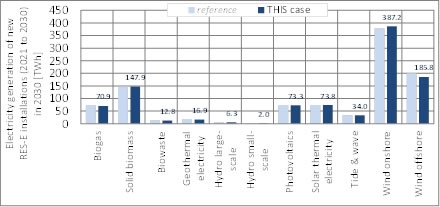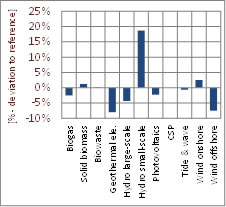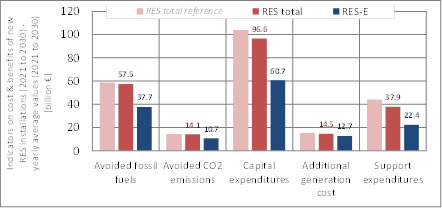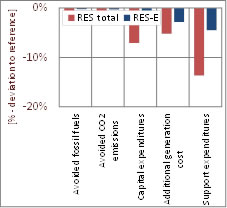| Reference case with minimum design standards
Brief characterisation: This pathway builds on the assumption that the current policy framework as given by the RES Directive (2009/28/EC) will be prolonged for the period up to 2030, meaning (inter alia) that national RES targets for 2030 will be established. Similar assumptions are consequently made for RES support – i.e. a continuation of strengthened national RES policies until 2030 which will be further optimised in the future with regard to their effectiveness and efficiency. In particular the further fine-tuning of national support schemes will require in case of both (premium) feed-in tariff and quota systems a technology-specification of RES support. |
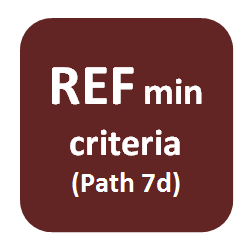 |
Minimum harmonisation is assumed to be in place under this reference variant, implying that MSs decide on both the type of support scheme that they apply as well as its design elements. However, minimum design criteria need to be considered for certain design elements. Consequently, in this modelling exercise the assumption is taken that technology-specific support levels may differ only to a limited extent across the EU 1. This brings up the need for intensified RES cooperation between MSs, where efficient and effective RES target achievement is envisaged at EU level, rather than simply the fulfilment of each national RES target using domestic resources. RES cooperation finally also affects the overall cost allocation across the EU – i.e. the ultimate height of support expenditures for RES at country level is defined by national RES deployment and the support expenditures related to that, and, on top of that, the additional revenues (for exporting countries) or additional expenditures (for importing countries) related to RES cooperation.
Figure 7d - 1. Technology-specific breakdown of RES-E generation from new installations (2021 to 2030) at EU-27 level in the year 2030, indicating deployment in absolute terms (left) and the change compared to reference (right) (for the assessed policy pathway 7d (REF min criteria))
Figure 7d - 2. Country-specific breakdown of RES and RES-E generation from new installations (2021 to 2030) in the year 2030, indicating RES(-E) deployment as share in corresponding demand (i.e. gross final energy demand for RES total, and gross electricity demand for RES-E) (for the assessed policy pathway 7d (REF min criteria))
Figure 7d - 3. Indicators on cost/expenditures and benefits of new RES(-E) installations (2021 to 2030), expressing yearly average (2021 to 2030) monetary values at EU-27 level in absolute terms (left) and the change compared to reference (for the assessed policy pathway 7d (REF min criteria))
Figure 7d - 4. Country-specific breakdown of yearly average (2021 to 2030) capital expenditures in new RES and RES-E installations (2021 to 2030), expressing investments as share of (country-specific) GDP (for the assessed policy pathway 7d (REF min criteria)
Figure 7d - 5. Country-specific breakdown of yearly average (2021 to 2030) support expenditures for RES total and RES-E, expressing expenditures as share of (country-specific) GDP (for the assessed policy pathway 7d (REF min criteria))
Figure 7d - 6. Yearly average (2021 to 2030) monetary transfers between Member States related to the support for RES, expressing additional expenditures (+) or income (-) as share of (country-specific) GDP (for the assessed policy pathway 7d (REF min criteria))
Note: Additional expenditure or income stems from the underlying cost allocation under a full or medium harmonisation of RES support, or they refer to RES cooperation in the case of soft, minimum or no harmonisation, respectively.
Scenario Viewer
1 More precisely, economic restrictions are applied to limit differences in applied financial support for certain RES technology among MSs to an adequately low level – i.e. differences in country-specific support per MWh RES are limited to a maximum of 10 €/MWhRES.
|



